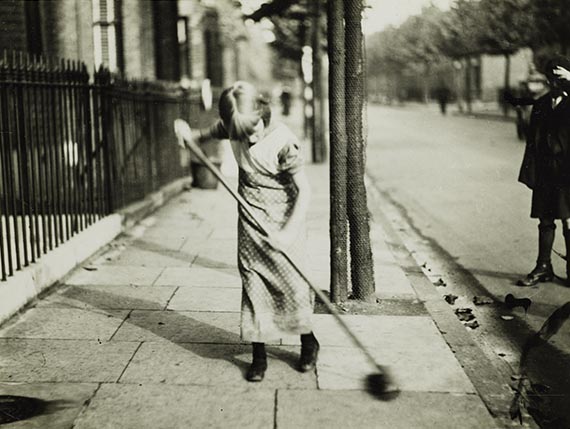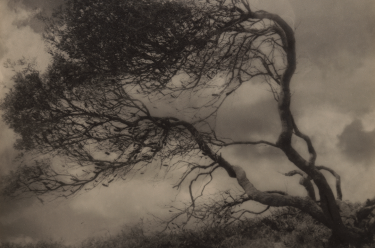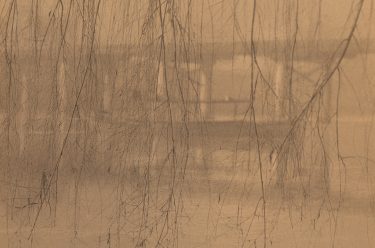
Two vintage gelatin silver photographic prints, Girl Sweeping, ‘Little Charwoman’, London 1934 and London Amusements c.1935 made by Emil Otto Hoppé (1878–1972) capture undoctored views of life in the British capital between the wars.
In the early decades of the twentieth century, EO Hoppé was one of the most successful and widely recognised photographers working out of Britain. Born in Munich, Germany, Hoppé moved to London in 1900, eventually establishing a fashionable photographic studio where he became known as a society portraitist. On assignment in New York in 1921, Hoppé began a series of topographical photographs of the city that altered radically the style and scope of his photographic practice. Between 1921 and 1938, he travelled the world — including coming to Australia in 1931 — photographing cities, industrial architecture, landscapes and people with a reportage-like authenticity that saw documentary photography take precedence over the staged glamour found in studio portraiture.
Between the first and second world wars, photography in Britain was, as elsewhere, shaped by both cultural and economic forces. While professional portrait photographers were faced with a contracting market, thanks largely to the rise of mass media, the demand for reportage and documentary photography expanded.
Like the vast majority of photographers working in the 1920s and 30s, the purpose of much of Hoppé’s work and travel was to compile material for publication in illustrated books and pictorial magazines. An astute businessman, he created an extensive inventory of images explicitly designed for commercial purposes, which he subsequently managed through the Dorien Leigh Photographic Agency, tellingly located at 30 Fleet Street. In doing so, he not only demonstrated his aptitude for adapting to the new economic realities of the period but also became a part of a pioneering generation of British social documentary photographers and filmmakers, which included John Grierson (1898–1972), and was followed a decade later by Humphrey Jennings (1907–50) and Bill Brandt (1904–83). Appearing in the monographs London Types Taken from Life (1926), The Image of London (1935) and A Camera on Unknown London (1935), the photographs Hoppé took of London in the 1920s and 30s are among the most comprehensive, candid and empathetic he created.

Unlike many of his contemporaries, Hoppé recorded the unpolished and unspectacular aspects of everyday life in the capital, without any apparent political conviction. Although remaining objective in his approach to subject matter, he shared in the development of a style of image production that became recognised as inherently English. Less concerned than their French and American counterparts with the junction between documentary photography and the formalist aspects of modern art, photographers in Britain established an unassuming style that was enormously influential on successive generations of photographers, filmmakers, artists and writers. With their gaze almost always fixed on the ‘ordinariness’ of the working classes, photographers such as Nigel Henderson (1917–85), playwright John Osborne (1929–94) and filmmakers led by Lindsay Anderson (1923–94) adopted an aesthetic and an implicit attitude towards art-making in the 1950s and 60s, one that emphatically championed the idea of undoctored authenticity over staged reality. They were echoing the English documentary style established decades earlier by influential figures, such EO Hoppé.
Sally Foster is former Assistant Curator International Art (pre 1975), QAGOMA
Subscribe to YouTube to go behind-the-scenes / Hear artists tell their stories / Read more about your Australian Collection / Know Brisbane through its Collection
#QAGOMA


I understand you sell DVD’s by Brian Doyle teaching kids how to draw. Do you have stock, price please and can I order on line. Thank you
Hi Graham. We will pass your request on to the QAGOMA Store and get back to you asap. Regards QAGOMA
Hi Graham. It is available instore at QAGOMA or online from us at this link: https://www.australianartbooks.com.au/books/products/drawing_for_fun_brian_doyle_dvd